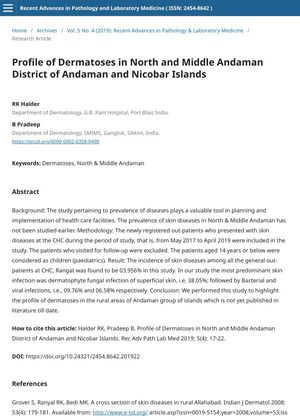TLDR Fungal infections were the most common skin problem in North & Middle Andaman.
The study conducted from May 2017 to April 2019 aimed to understand the prevalence of skin diseases in North & Middle Andaman, a region not previously studied. The study included newly registered out-patients with skin diseases at the CHC, excluding those who visited for follow-up. Children were defined as patients aged 14 years or below. The incidence of skin diseases among all the general out-patients at CHC, Rangat was found to be 03.956%. The most predominant skin infection was dermatophyte fungal infection of superficial skin, accounting for 38.05% of cases, followed by bacterial and viral infections, which accounted for 09.76% and 06.58% respectively.
 5 citations
,
January 2014 in “Indian Journal of Dermatology, Venereology and Leprology”
5 citations
,
January 2014 in “Indian Journal of Dermatology, Venereology and Leprology” Non-infectious skin conditions are more common than infectious ones in Kashmir, but community areas see more infections, suggesting a need for better skin care services in primary health care.
 January 2018 in “Springer eBooks”
January 2018 in “Springer eBooks” Athletes need effective management of skin disorders for their performance and well-being.
 7 citations
,
October 2013 in “British Journal of Dermatology”
7 citations
,
October 2013 in “British Journal of Dermatology” HIV can cause skin disorders, which are often the first sign of infection, especially in people with darker skin.
29 citations
,
December 2021 in “Pharmaceutics” Phospholipid soft vesicles improve topical drug delivery for better skin condition treatments.
 November 2017 in “Research Journal of Health Sciences”
November 2017 in “Research Journal of Health Sciences” Skin infections and eczema were most common in all ages, acne in teens and young adults, and nutritional skin problems and infestations in children.
 15 citations
,
March 2014 in “General Hospital Psychiatry”
15 citations
,
March 2014 in “General Hospital Psychiatry” Patients with schizophrenia have a high rate of skin diseases, with fungal infections and dermatitis being most common, and those on clozapine have a lower risk of fungal infections.





